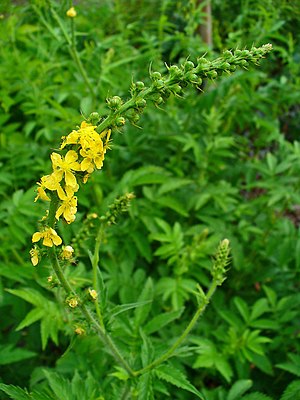Great ormennig
| Great ormennig | ||||||||||||
|---|---|---|---|---|---|---|---|---|---|---|---|---|

Large ormennig ( Agrimonia procera ) |
||||||||||||
| Systematics | ||||||||||||
|
||||||||||||
| Scientific name | ||||||||||||
| Agrimonia procera | ||||||||||||
| Wallr. |
The great Odermennig ( Agrimonia procera ), also fragrant Odermennig , is a species in the subfamily of the Rosoideae . Agrimonia procera may have originated in culture. It used to be used as a medicinal plant.
Description and ecology
The Große Odermennig is a deciduous, rosette-free, perennial herbaceous plant ( hemicryptophyte ) that reaches heights of 50 to 180 centimeters. It forms a rhizome . The underside of the leaves is green to gray-green, slightly hairy and never tomentose. There are numerous sedentary glands with an aromatic lemon-like scent. The petals are mostly sanded. Bell-shaped aggregate fruits are formed, the upper half of which can be furrowed wide and shallow to almost not furrowed.
The flowering period extends from June to August. There is insect pollination or self-pollination instead. The fruits are spread by Velcro spread.
The number of chromosomes is 2n = 56.
Occurrence
The Große Odermennig has a sub-Atlantic-sub-Mediterranean distribution area. With a few exceptions in West Asia , its area is limited to all of Europe ; it extends from Central, Western and Southern Europe north to southern Finland and east to Ukraine . It shares the same northern border as Agrimonia eupatoria , but is otherwise more common than this one. In Germany, this species is widespread in Schleswig-Holstein, rare in Baden-Württemberg, Thuringia and Saxony and scattered in the rest of the federal states.
The Großer Odermennig grows on the edges of fresh forests and hedges, on forest paths and on ruderal sites such as roadsides, railway systems and quarries. He avoids lime. In the Allgäu and its surroundings, it climbs up to 1,320 m at the summit of the Hittisberg in Vorarlberg.
Taxonomy
The first description of Agrimonia procera was made in 1841 by Frederick William Wall Roth . A synonym for Agrimonia procera Wallr. is Agrimonia odorata auct. non Mill.
literature
- Eckehart J. Jäger, Klaus Werner (Ed.): Excursion flora from Germany . Founded by Werner Rothmaler. 10th edited edition. tape 4 : Vascular Plants: Critical Volume . Elsevier, Spektrum Akademischer Verlag, Munich / Heidelberg 2005, ISBN 3-8274-1496-2 .
Individual evidence
- ^ Oskar Sebald, Siegmund Seybold, Georg Philippi (ed.): The fern and flowering plants of Baden-Württemberg . tape 3 : Special part (Spermatophyta, subclass Rosidae): Droseraceae to Fabaceae . Eugen Ulmer, Stuttgart (Hohenheim) 1992, ISBN 3-8001-3314-8 , pp. 103-104 .
- ↑ Erhard Dörr, Wolfgang Lippert : Flora of the Allgäu and its surroundings. Volume 2, IHW, Eching 2004, ISBN 3-930167-61-1 , p. 60.
- ↑ Friedrich Wilhelm Wall Roth: Σχολιον to Hampe's Prodromus Florae hercyniae. A letter to the pharmacist Mr. Ernst Hampe zu Blankenburg from the Hofrathe Dr. Wallroth. In: Linnaea. Volume 14, No. 6, pp. 1–158, 529–704 (here: p. 573), digitized .
Web links
- Agrimonia procera in the Germplasm Resources Information Network (GRIN), USDA , ARS , National Genetic Resources Program. National Germplasm Resources Laboratory, Beltsville, Maryland. Retrieved December 30, 2013.
- Great ormennig. In: FloraWeb.de.
- Distribution map for Germany. In: Floraweb .
- Agrimonia procera Wallr. In: Info Flora , the national data and information center for Swiss flora .
- Distribution in the northern hemisphere from: Eric Hultén, Magnus Fries: Atlas of North European vascular plants. 1986, ISBN 3-87429-263-0 at Den virtuella floran. (swed.)
- Thomas Meyer: Data sheet with identification key and photos at Flora-de: Flora von Deutschland (old name of the website: Flowers in Swabia )



